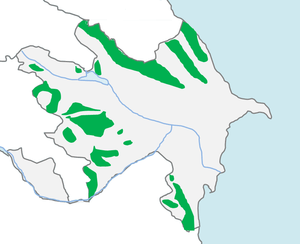Forests of Azerbaijan

The total forest area of Azerbaijan is 1,021,880 ha or 11.8% of the country's area.[1] The forest biomes consist of temperate deciduous forests, temperate broadleaf and mixed forests, temperate coniferous forests and riparian forests.[1] Specialists estimate that in the 8th-9th centuries the forest cover was around 30-35%, most of it situated in mountainous areas.[1]
While as a whole, Azerbaijan is a country with modest forest cover, the forest cover is unevenly spread across the country. In the low-lying areas, the forest cover is very sparse, also due to the fact that the precipitation is too low for trees and forests to grow in most of these areas; whereas in many mountainous areas, the forest cover is much greater especially in wetter areas.[1]
49% of the country's forests are located in the Greater Caucasus Mountains, 34% in the Lesser Caucasus Mountains, 15% in the Talysh Mountains-Lankaran Lowland region, 2% in the Kur-Araz Lowland, and 0.5% in the Nakhchivan Autonomous Republic.[1]
The forests are classified into two major ecoregions in Azerbaijan: the Caucasus mixed forests of the Greater Caucasus Mountains and the Lesser Caucasus Mountains, and the Caspian Hyrcanian mixed forests of the Talysh Mountains-Lankaran Lowland region.
Flora
Azerbaijan preserves many endemic tree and shrub species, relicts of the Tertiary period which were not affected by Pliocene and Pleistocene glaciations.
The forests of Azerbaijan account for 150 endemic species of trees and bushes out of 435 species of trees and bushes. Some endemic tree species are, the Hyrcanian box tree (Buxus hyrcana), Caucasian pear (Pyrus communis subsp. caucasica), Lenkoran acacia (Albizia julibrissin), chestnut-leaved oak (Quercus castaneifolia), Caucasian oak (Quercus macranthera), Caucasian ash (Fraxinus angustifolia subsp. oxycarpa), European ash (Fraxinus excelsior), European hornbeam (Carpinus betulus), Oriental hornbeam (Carpinus orientalis), Oriental beech (Fagus orientalis), Caucasian persimmon (Diospyros lotus), Caspian locust tree (Gleditsia caspica), Caucasian alder (Alnus subcordata), black alder (Alnus glutinosa subsp. barbata), white poplar (Populus alba) Caucasian wingnut (Pterocarya fraxinifolia), Persian ironwood (Parrotia persica), Caucasian zelkova (Zelkova carpinifolia), butcher's broom (Ruscus aculeatus), velvet maple (Acer velutinum), Cappadocian maple (Acer cappadocicum), wych elm (Ulmus glabra), Caucasian lime tree (Tilia dasystyla subsp. caucasica), wild cherry (Prunus avium), wild service tree (Sorbus torminalis), sweet chestnut (Castanea sativa), Nordmann fir (Abies nordmanniana) among many others.
Management and protection
All forests are owned by the state and are under the management of the Ministry of Ecology and Natural Resources of Azerbaijan, and forest land usage is limited by law and industrial cutting is forbidden. The "Forest Code" of the Republic of Azerbaijan and the "Law of the Azerbaijan Republic on Environmental Protection" are the main legal documents regulating the protection and management of forests in the country.[2]
The "National Program on restoration and expansion of forests in the Azerbaijani Republic" adopted for the period 2003-2008 contributed partially to the improvement of the situation: over the last 6 years forest restoration actions were carried out on more than 71,634 hectares of forest land, and a large number of trees were planted. According to the Forest Development Department of the Ministry of Ecology and Natural Resources of Azerbaijan during the 2013 large-scale forest restoration activities were carried out at the territory of 1031 ha.[2]
Problems
The Azerbaijani forests experience problems of different characters. Most of them are linked with the lack of awareness among the local population on issues of sustainable forest management, impact of climate change on the forests and the insufficient enforcement of existing laws on forest protection.[2]
The occupation of the part of the country's territory by Armenia (Nagorno-Karabakh and the territories surrounding it) caused a significant damage to the forests, especially those located in the mountainous areas.[2]
Another critical problem is the continuous practice of illegal grazing for firewood in the forests which are damaging the biodiversity and are resulting in economic and social losses. Illegal logging remains a challenge for the Azerbaijani forest sector since country’s independence.[2]
Due to the poor management in many regions, and especially villages located in proximity to the forests, acts of illegal logging exist and pose a significant threat to the forests. The same threat comes from the unsustainable tourism and recreation practices. At the same time the forests of Azerbaijan feel the impact of the global climate change with an increase of forest fires during the summer.[2]
References
- 1 2 3 4 5 "Forests of the Republic of Azerbaijan". Ministry of Ecology and Natural Resources of Azerbaijan. Retrieved 29 January 2016.
- 1 2 3 4 5 6 "Forests of Azerbaijan". ENPI. Retrieved 29 January 2016.
External links
| Wikimedia Commons has media related to Forests in Azerbaijan. |
- Ministry of Ecology and Natural Resources of Azerbaijan (Azerbaijani) (English)